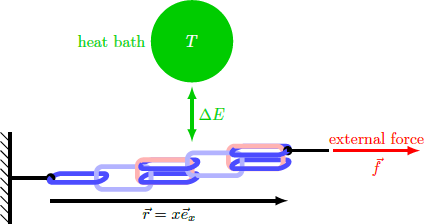Rubber Physics (Part 7)

Now consider the case where a one-dimensional linear chain of N chain links of length l is connected to a heat bath at room temperature T = 2 9 3 K , so that heat exchange with the environment takes place. In addition, a external force f = f e x acts on the chain. As already shown in part 4 , the alignments l i = ± l e x of the chain links are binomially distributed. However, the probabilities p + and p − for the alignment in positive and negative x-direction, respectively, are now different and obey a Boltzmann distribution: p + p − A = A exp ( + k B T l f ) = A exp ( − k B T l f ) = exp ( + k B T l f ) + exp ( − k B T l f ) 1 = 2 cosh k B T l f 1 with the Boltzmann constant k B ≈ 1 . 3 8 ⋅ 1 0 − 2 3 J / K . The pre-factor A is chosen so that the normalization condition p + + p − = 1 is met. Calculate the mean value ⟨ x ⟩ of the displacement for the vector r = x e x that connects the beginning and the end of the chain. Derive an equation for the linear force constant k of the chain with k = ( ∂ ⟨ x ⟩ ∂ f ) ⟨ x ⟩ = 0 = ( ∂ f ∂ ⟨ x ⟩ ) f = 0 − 1 Give as result the numerical value for the force constant k with two significant digits in units of newtons per meter. Assume a unit length l = 0 . 3 5 nm and a number N = 1 0 4 of chain links.
The answer is 0.0000033.
This section requires Javascript.
You are seeing this because something didn't load right. We suggest you, (a) try
refreshing the page, (b) enabling javascript if it is disabled on your browser and,
finally, (c)
loading the
non-javascript version of this page
. We're sorry about the hassle.
We want to find out the following mean value ⟨ x ⟩ = ⟨ r ⟩ ⋅ e x = ⟨ n ⟩ l = ( 2 ⟨ N + ⟩ − N ) l with the number N + = 0 , 1 , … , N chain links aligned in positive x-directions, that is bionomially distributed. We have already shown in part 4, that this mean value results ⟨ N + ⟩ = N p + Therefore, we get a displacement ⇒ ⇒ ⟨ x ⟩ ∂ f ∂ ⟨ x ⟩ k = ( 2 N p + − N ) l = N l ( e β l f + e − β l f 2 e β l f − 1 ) = N l e β l f + e − β l f 2 e β l f − ( e β l f + e − β l f ) = N l e β l f + e − β l f e β l f − e − β l f = N l cosh ( β l f ) sinh ( β l f ) = N l tanh ( β l f ) = β N l 2 cosh 2 ( β l f ) sinh ′ ( β l f ) cosh ( β l f ) − sinh ( β l f ) cosh ′ ( β l f ) = β N l 2 cosh 2 ( β l f ) cosh 2 ( β l f ) − sinh 2 ( β l f ) = β N l 2 cosh 2 ( β l f ) 1 = ( ∂ f ∂ ⟨ x ⟩ ) f = 0 − 1 = β N l 2 1 = N l 2 k B T with the reciprocal value β = k B T 1 of the thermal energy. Numerical evaluation yields k = 1 0 4 ( 0 . 3 5 ⋅ 1 0 − 9 m ) 2 1 . 3 8 ⋅ 1 0 − 2 3 J / K ⋅ 2 9 3 K ≈ 3 . 3 ⋅ 1 0 − 6 m N